More than a decade after moving to Chek Lap Kok on Lantau Island, the Hong Kong International Airport (HKIA) has become one of the most recognisable air passenger terminals in Asia-Pacific. Two gleaming terminals with a total of 224 retail shops and 70 F&B outlets, as well as efficient and user-friendly services create the epitome of a duty-free city. HKIA also continues to be among the busiest in the region, handling over 46 million passengers last year.
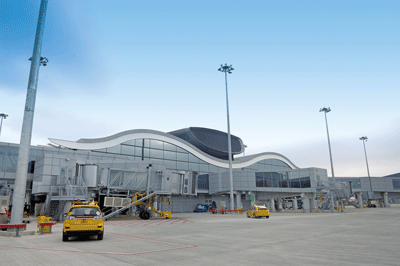
As one of the top global hubs, HKIA connects Hongkong – the centre for international business in Asia – to 150 destinations worldwide, including 40 Mainland Chinese cities. About 90 airlines serve this airport, which operates round the clock. Continuous upgrades have been made to keep the airport on par with shifting aviation and passenger demands, making it one of the most efficiently run air terminals.
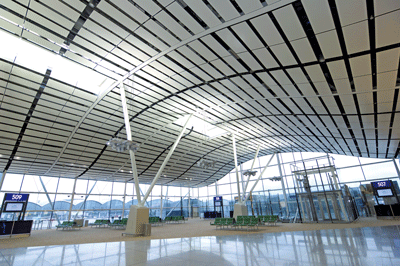
North Satellite Concourse
Flying home for Christmas, I vaguely noticed the signages for new boarding gates 501 to 510. The two-storey North Satellite Concourse (NSC) building at Terminal 1 had just opened.
The 10 airbridge-served parking stands at the HK$1 billion (US$128.87 million) facility are designed to accommodate the increasing number of narrow-bodied, single-aisle aircraft landing at HKIA. To date, about one third of the aircraft using the airport are Airbus A320 and Boeing B737, whose average capacity is 150 seats. The building is situated north of T1.
“With the new satellite concourse, less than 10 flights will need to be parked at remote bays every day, compared with the 40 to 50 flights in the past,” says Howard Eng, executive director for airport operations at Airport Authority Hong Kong. “This means more passengers can embark or disembark their aircraft in a pleasant, weather-proof environment, sparing them the inconvenience of being exposed to hot and rainy weather.” The NSC is expected to handle five million passengers a year initially.
Landing slots at NSC are randomly rotated among various airlines, although an airport spokesperson notes that carriers from Mainland China, which operate smaller planes, are the ones primarily using the new facility.
After the holidays, I went to HKIA and checked out the new concourse.
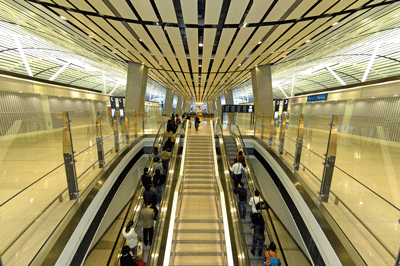
Passengers whose aircraft are departing from NSC will still have to check in and go through immigration procedures either at T1 or T2. After that, they have to take a shuttle bus from a designated area of T1 to NSC. The shuttle bus service runs between T1 and NSC every four minutes. Likewise, arriving passengers disembarking from NSC will have to take the shuttle bus to T1 and from there, proceed with the usual immigration, customs and baggage claim procedures.
I noted how the airport engineers kept passenger comfort in the designing the NSC. Passengers with disabilities and those carrying heavy hand luggage need not worry about hopping on and off the shuttle bus. When the bus arrives at NSC, the driver activates a metal platform to connect the vehicle to the NSC platform, which is set at the same height. This allows passengers to walk on an even surface during the transfer between NSC and T1. The distance between T1 and NSC is less than five minutes.
The NSC’s architecture features a lot of glass that harnesses natural daylight. The entire facility has a floor area of 20,000sqm. All departures and arrivals commence on the second-floor boarding area, where 10 retail shops and two F&B outlets are also located. Other amenities include complimentary Wi-Fi internet access, public toilets and dedicated diaper-changing rooms.
Transit passengers whose plane lands at NSC do not have to go to T1 if their connecting flight will be taking off at NSC. There is already a transfer area on the ground floor of the building.
SkyPier ferry services
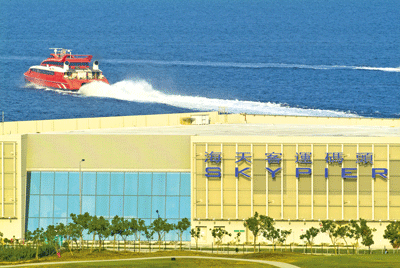
With the close economic ties between Hongkong and its neighbours in the Pearl River Delta (PRD), HKIA has always seen to it that air travellers transiting to their final destination in South China experience a seamless journey. Opened in 2003, the SkyPier ferry terminal enables international travellers and PRD residents to bypass Hongkong immigration and customs while making use of HKIA facilities. SkyPier allows them to cut journey time and makes their air-to-sea and sea-to-air transfers more hassle free.
The Airport Authority unveiled its new SkyPier in December to improve connectivity to the PRD region. While at HKIA, I took the opportunity to see this facility as well.
The 16,500sqm complex, situated in the eastern tip of the airport island, is eight times larger than the old SkyPier, which had always been meant as a temporary structure. The airport’s Automated People Mover (APM) train has now been extended to the new SkyPier, cutting by half the travel time between HKIA and the ferry pier to four minutes.
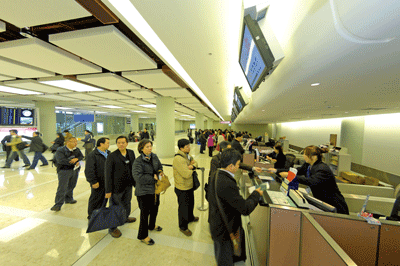
As before, the SkyPier is solely for the use of transit passengers, so only those with valid air tickets can purchase ferry tickets either at HKIA or at the PRD ports. (See story above, “Transfers from HKIA to SkyPier”.
The SkyPier is designed to accommodate eight berths, although there are only four at the moment. When fully operational, it can handle eight million passengers annually.
To date, the high-speed ferries make an average of 85 trips a day, shuttling about 5,000 passengers between HKIA and eight ports located in Zhongshan, Zhuhai, Jiuzhou, Dongguan Humen, Guangzhou Nansha, Shenzhen Shekou and Shenzhen Fuyong in China as well as the Taipa and Maritime Ferry terminals in Macau.
The SkyPier is equipped with 20 airline check-in desks and five security-screening channels to ease the traffic flow of outbound travellers from the PRD transiting through the HKIA. About 60 airlines process outbound passengers from South China at the new facility.
And to make life easier for these travellers, HKIA has allowed nine airlines to allow check in to be conducted at major ports of origin such as Dongguan Humen, Fuyong, Shenzhen Shekou and Macau Maritime Ferry Terminal.
Among the airlines participating in this expedited check-in scheme are All Nippon Airways, Japan Airlines, Cathay Pacific, Dragonair and Taiwan’s EVA Air. This means passengers do not have to wait until their ferry docks at the SkyPier to check in for their flight, and another good thing is that their checked bags are tagged all the way through to be picked up at the final destination.
Outbound passengers from the PRD must arrive at the designated port 30 minutes before the ferry departs. Sufficient time must be allotted for the ferry’s journey time (ranging from 30 to 90 minutes) as well as another two hours for transfer, check in and security screening.
Passengers need to remember to collect their tax refund coupon upon check in, for transit passengers are exempted from paying the HK$120 (US$15) airport departure tax. They can claim their prepaid airport tax at the refund counter at the SkyPier. The Airport Authority strongly advises passengers to plan their time so that they arrive at the SkyPier at least 90 minutes before their flight is set to take off.
Future enhancements
According to senior executives at the Airport Authority, the NSC and SkyPier are only a part of the HKIA’s near-term growth projects estimated at HK$4.5 billion (US$579.90 million) to enhance service levels and meet future demand.
Other key highlights of the near-term enhancement programme include reconfiguration of the Departures Immigration Halls to increase HKIA’s security-screening capacity by 40 percent and the expansion of the transfer area. Furthermore, the airport’s baggage-handling system is being upgraded and the two Arrivals Immigrations halls are being consolidated into a single spacious area. All these are set for completion by 2011.
Already, the airport management is working on the development of HKIA’s midfield area and it is also ironing out the long-term HKIA Master Plan 2030.
“By being able to meet future demand, Hongkong can maintain its position as a leading international and regional aviation centre and the preferred gateway to the Mainland,” says Airport Authority chief executive Stanley Hui.
For more information, visit www.hongkongairport.com
TRAVELLER’S OASIS
Travelers’ Lounge has opened a third facility at Hong Kong International Airport (HKIA). Located in the East Hall, near departure gate 1, the 1,394sqm lounge can seat up to 300 passengers and features amenities such as showers, an exclusive resting area, all-day dining, a bar, beauty salon and spa. The Library, designed for small meetings, can accommodate eight people.
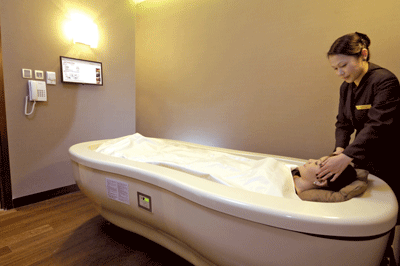
The new pay-for-use lounge complements its sister facility, the first Travelers’ Lounge near departure gate 35 at the west side of the airport. Both can be found at airside. The third outlet, called Plaza Premium Lounge, is at the airport’s non-restricted arrivals area.
The 24-hour Travelers’ Lounge (East) has a designated area for First and Business Class passengers of airlines that do not operate their own lounge at HKIA. Premium travellers of EVA Air, Japan Airlines, Malaysia Airlines, Qatar Airways, SWISS Air and Ethiopian Airlines enjoy complimentary access to this lounge.
“While the airlines fulfil the need of 15 percent of airport users who fly First and Business Class, our vision is to extend this service ethos to 85 percent of travellers who fly Economy Class, or increasingly, passengers of budget airlines that provide no lounge access,” says Song Hoi-See, founder and CEO of Plaza Premium Lounge Management.
Premium members of credit card companies such as American Express, Bank of China, Citibank and China Trust are also eligible to the free access. The list of complimentary lounge services varies from card to card. Holders of the Priority Pass card also get free access to the lounge.
The lounge accepts walk-in passengers. Fees range between HK$400 (US$53) for two hours and HK$600 (US$79) for 10 hours. The standard lounge package includes shower, salad bar, hot meal, non-alcoholic drinks, workstations with internet access, Wi-Fi, TV, newspapers, magazines and a choice of seated massage, oxygen therapy or water-bed therapy for 15 minutes. Alcoholic drinks and spa treatments are chargeable.
POINTS TO KEEP IN MIND
Determine what you want to achieve from your frequent flyer programme – is it upgrades, free flights, services like car rental or merchandise?
Use the internet to determine which FFP suits your needs best. Check out various forums and blog sites to learn from the experiences of other passengers.
Your specific travel habits should be taken into consideration when choosing the FFP to join. No FFP has all the advantages but there should be one that answers most of your needs.
Look beyond the airline whose FFP you’ve joined and to the alliance that it’s a member of. Are the partners offering good connections?
It should be sufficient to be a member of two programmes that belong to two different airline alliances. That way you can still earn points on the partner airlines and avail of wider connectivity.
Competition between the airlines is so keen these days, it’s a members’ market – take advantage of the never-ending stream of promotions and incentives.








